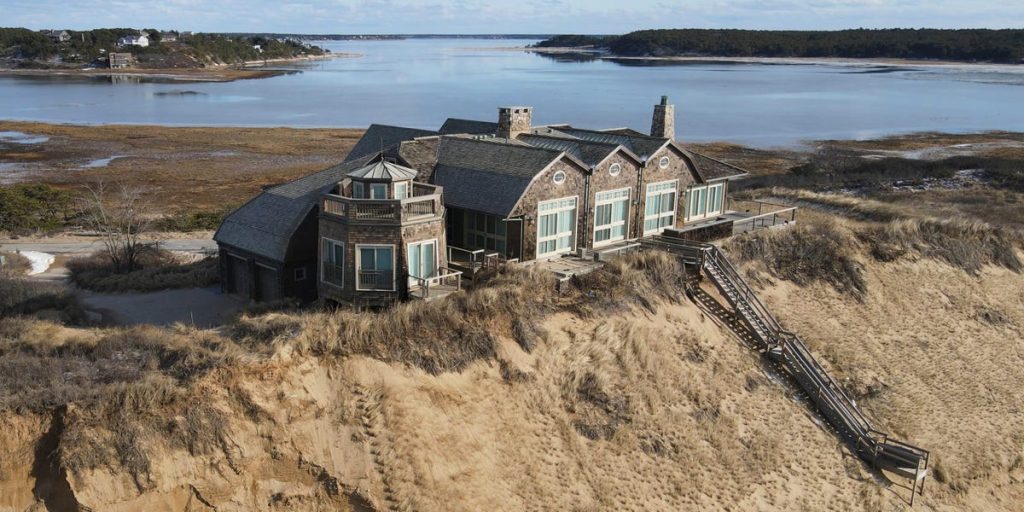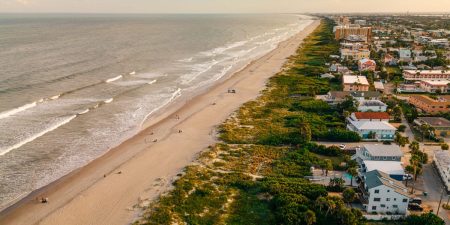The Plight of Coastal Mansions: A Battle Against Erosion
The scenic coastlines of New England, particularly in Cape Cod and Nantucket, are home to some of the most stunning luxury properties in the country. However, these picturesque mansions are now facing an existential threat—coastal erosion, fueled by the climate crisis. A mansion perched on a bluff in Wellfleet, Massachusetts, is one such property teetering on the edge of collapse. Built in 2010, this five-bedroom home with an elevator and a sprawling porch once offered breathtaking views of Cape Cod Bay. Today, it’s a symbol of the dangers of climate change and the precariousness of living on the edge of the ocean. Over the past decade, the bluff beneath this mansion has receded by 54 feet, leaving its future uncertain. This home is not an isolated case; it’s part of a growing trend of luxury properties in New England losing their battle against the encroaching sea.
A Growing Crisis in Coastal Communities
The issue of coastal erosion is not new, but its acceleration due to rising sea levels and more frequent storms has made it a pressing concern for many communities. In Nantucket, another affluent island, the situation is equally dire. Homebuyers and locals alike are grappling with the reality of watching their investments crumble into the ocean. One Nantucket homebuyer openly admitted regretting his decision to purchase a cliffside property, despite knowing the risks. His story is a stark reminder of the consequences of building on unstable ground. The erosion is not only a financial loss for homeowners but also a threat to local ecosystems. In Wellfleet, the potential collapse of the mansion has raised concerns about the local oyster industry, which employs a significant portion of the town’s residents. The fear is that debris from the home could harm the oyster beds, dealing a devastating blow to the town’s economy.
The Fight to Save a Sinking Mansion
The Wellfleet mansion has been at the center of a heated debate about responsibility and action. Attorney John G. Bonomi, Jr., purchased the property in 2022 for $5.5 million, despite clear signs of erosion. The previous owners had attempted to persuade the town to install protective measures, such as seawalls, but their efforts were unsuccessful. At a January 15 meeting of the Wellfleet Conservation Commission, Bonomi’s lawyer, James Gallagher, admitted that saving the house was no longer feasible. “My client really wanted to save the house, but it’s just not possible at this point,” Gallagher told the commission. However, the suggestion to do nothing and allow the house to fall into the water was met with resistance from town officials like Lecia McKenna, who questioned the lack of action. The town has already taken some steps, removing part of the house’s deck and a bedroom last year under an emergency order. Yet, the bigger question remains unresolved: Who will be responsible for dismantling the house—Bonomi or the town? The commission has deferred the decision until June, leaving the fate of the mansion hanging in the balance.
The Ripple Effects of Erosion
The Wellfleet mansion is not the only luxury home battling the forces of nature. In recent years, several other high-end properties in Massachusetts have succumbed to erosion. Billionaire Barry Sternlicht lost his Nantucket home, purchased for $610,000 in 2010, to the relentless pounding of the sea. Similarly, a waterfront home nearby saw its value plummet from $2.3 million to $600,000 due to the rapidly disappearing bluff it once stood on. These stories highlight the financial and emotional toll of coastal erosion on homeowners. Despite the risks, some buyers are still tempted by the discounted prices of these properties, hoping to enjoy a few more years of luxury before the inevitable happens. Take the case of Don Vaccaro, a businessman who bought a three-bedroom property in Nantucket for $200,000 in July 2024. The home, originally listed at $2.2 million, was already on shaky ground. Just six months later, the town ordered the house to be demolished to prevent it from being swallowed by the ocean. Vaccaro, who spent an additional $200,000 trying to save the property, now regrets his decision. “It was a terrible investment,” he said. “I hoped to have the summer of 2025, but that will not happen.”
The Environmental and Economic Stakes
As more homes teeter on the edge of the ocean, the environmental and economic stakes grow higher. If the Wellfleet mansion were to collapse, it would release a host of materials into the water, including fiberglass insulation and other toxic substances. These materials could contaminate the nearby oyster beds, which are not only a vital part of the local ecosystem but also a cornerstone of Wellfleet’s economy. Over 15% of the town’s permanent residents depend on oyster harvesting for their livelihood. The collapse of the oyster industry would have far-reaching consequences, affecting everything from local businesses to the town’s reputation as a destination for fresh seafood. The situation underscores the interconnectedness of environmental health and economic stability. “The house has a lot of fiberglass insulation in it,” warned John Cumbler, a member of the Wellfleet Conservation Commission. “It could endanger the oyster industry in Wellfleet, our major industry outside of tourism.”
The Challenge of Cleanup and the Future of Coastal Living
The growing number of luxury homes falling into the ocean also raises questions about cleanup efforts and the long-term sustainability of coastal living. Unlike the modest beach houses of the past, today’s mansions are sprawling structures with elaborate designs and materials. When they collapse, the debris left behind is far more substantial and difficult to manage. “They’re not your classic beach house,” said Greg Mckechnie, a real-estate agent with 25 years of experience on Nantucket. “When I was a kid, if a house flooded down on Hulbert Avenue, you’d go get a broom, sweep the water out, and wait for it to dry.” Today, the situation is much more complex, with the potential for widespread pollution and harm to marine life. As the climate crisis intensifies, experts warn that the challenges posed by coastal erosion will only grow worse. In Nantucket, for instance, the town’s 2021 Coastal Resilience Plan noted that erosion is expected to worsen in the foreseeable future, with some coastlines losing over 100 feet in the last decade. The report ominously stated, “The risks for Nantucket, a maritime community, are significant.” As the ocean continues its relentless march inland, the future of coastal living hangs in the balance. Will communities find a way to adapt and protect their homes, or will the lure of the sea prove too great to resist? Only time will tell.












